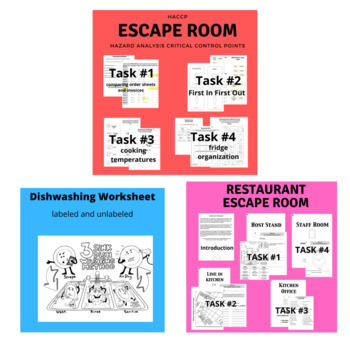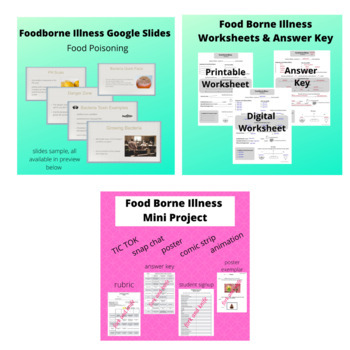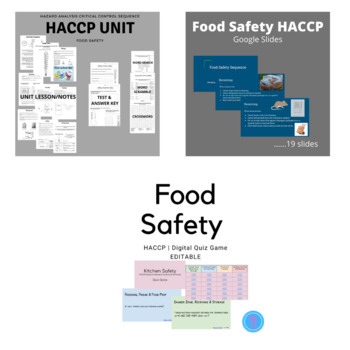Food Safety Bundle For The Cooking And Family Consumer Science Classroom
- Zip
- Easel Activity

Products in this Bundle (9)
showing 1-5 of 9 products
Bonus
Also included in
- Are you looking to create a library of materials for your culinary, cooking and bakeshop classroom? In my family consumer science classroom I use these materials to teach units about food safety, individual culinary skills, kitchen math and games. These units form the foundation of my culinary classPrice $297.68Original Price $425.25Save $127.57
Description
Are you looking for a variety of ways to teach and discuss food safety with your cooking and culinary students? In my hospitality classroom I use these digital quizzing game, google slides, notes, tests, posters, print and go activities to teach and reinforce the facts of food safety.
I enjoy using many visuals in my teaching and tests to help my students understand and retain the information they need to learn. This bundle is a great was you get multiple activities about food safety at a discounted bundle price!
These materials on food safety in the kitchen go through what it is, how it happens and the viruses and bacteria to watch out for. Once food gets into the clean and safe kitchen students need to know how to keep it that way with Hazard Analysis Critical Control Points (HACCP).
****************************************************************************************
Food Safety Google Slides
Kick off your Food and Kitchen Safety Unit about food borne pathogens and food poisoning. This power point covers food borne illness. The slides include the topics of:
- symptoms
- definition
- how it happens
- contamination types - chemical, physical, allergens microbiological
- viruses, parasites, bacteria, protozoa, mould, yeast
- bacteria - anaerobic, anaerobic,
- conditions of bacterial growth - protein, oxygen, acidity, moisture, temperature
Worksheet:
- digital
- printable
- answer key
Guides the student through the power point showing them important parts where notes should be taken.
National Standards for Family and Consumer Sciences
8.2.1 Identify characteristics of major food borne pathogens, their role in causing illness, foods involved in outbreaks, and methods of prevention.
****************************************************************************************
HACCP Hazard Analysis Critical Control Point
Lesson - Scaffolded Notes - Activity
This is the sequence food goes through before it reaches the guest. The goal is to keep the food from ‘going bad’, growing bacteria or being exposed to harmful chemical or substances like hair or glass.
All foods do not go through these stages and they might not go through them
in this order. Smoothies don’t get cooked or reheated. All food will go through
some of these stages. It is important to control temperatures during all of these stages to make sure bacteria has a very little chance to grow. Listed below are the stages in the food safety sequence:
- Receiving
- Storage
- Freezing
- Refrigeration
- Food Preparation
- Thawing
- Cooking
- Hot and Cold Holding
- Cooling
- Reheating
This package includes a lesson page on each section in the sequence listed above. It covers the topics of:
- time-temperature sequence
- danger zone
Some of the pages have activities on them like shading in the danger zone temperatures on a the thermometer or identifying the cooking temperatures for meat. All measurements are in Celsius and Farenheit.
The package also includes activities about safety sequence vocabulary and definitions:
- Crossword
- Word Search
- Word Scramble
Quiz
I have included an answer key but left the amount each question is worth up to you. I know some teachers mark for spelling and some don't or some only mark for spelling on newly taught vocabulary words. Whatever the case the answer key is there to help make marking quick.
National Standards for Family and Consumer Science
8.2.4 Use the Hazard Analysis Critical Control Point (HACCP) and crisis management principles and procedures during food handling processes to minimize the risks of food borne illness.
***********************************************************************************************************
Escape Room Activity - Storage Room (HACCP)
This escape room is designed to support your food safety curriculum. It can coordinate with my HACCP lesson and scaffolded notes. It begins with a scenario that can be read to the class and 4 activities that need to be completed.
The scenario: you came in early to the restaurant you work at to receive the delivery and put it away. The rest of the staff won't be there for hours. While putting away items in the storeroom you accidentally knocked the door stop, causing the door to close and now you are locked inside. The order is still out on the counter, the meats, cheeses, dairy etc and you need to get out there to make sure things don't go bad, or else.....you loose your job, the restaurant closes because of all the money they lost, people no longer have you great food to eat. Now where is that backup store room key????
This is the point where you introduce the class to their first task however you choose to divide the activities up. Everyone can be working on the same activity at one time or each group is on a different activity or a bit of both. When a group has completed all the activities their is a 'key' to get out of the storeroom you can give them.
Activities:
Purchase Order vs. Order Invoice
This activity is to introduce the students to proper receiving technique. When an order is delivered the delivery person will give you a sheet stating everything they have brought (order invoice). You as the receiver will look at your sheet (purchase order) of what you ordered and see that the two pieces or paper match. If they don't, where they don't, so alternative plans can be made to get the product or correct errors like too much, too little, wrong item, wrong size etc.
First In First Out FIFO
This activity is sorting items by their expiration date. Putting the items that will expire first at the front of the line to be used. This game includes labels you can cut out and put on recycled or empty containers and students need to arrange them in a mock storeroom.
Temperature Challenge
This activity focuses on students knowing the correct minimum internal temperature a variety of items need to be cooked to. Students are given a page with pictures of food they must cut out and arrange in the right spot on a paper thermometer.
Refrigeration
This activity is about arranging your fridge correctly so foods on the upper shelves don't accidentally contaminate foods on the lower shelves. This is a scenario that helps students understand why ground beed that has to be cooked to 165F shouldn't be on the shelf about a cheese platter because what if the raw beef juices dripped down onto the cheese platter which doesn't have to be cooked at all?
National Standards for Family and Consumer Science
8.2.11 Demonstrate ability to maintain necessary records to document time and temperature control, HACCP, employee health, maintenance of equipment, and other elements of food preparation, storage and presentation.
ProStart Level 1 B-Keeping Food Safe
#25. List the HACCP principles and explain their importance to food safety.
***************************************************************************************************************
Dishwashing Poster/Worksheet
What is a major way to promote food safety? Proper cleaning and sanitation of equipment.
This poster comes labeled and unlabeled. It also come with a suggestion sheet for teachers on how the posters can be used to teach the 3 sink dishwashing method in their classroom.
The poster shows the order of the 3 sink dishwashing method.
- SCRAPE
- WASH with hot and soapy water
- RINSE in clean water
- SANITIZE for 45 seconds in a bleach water solution (1/2 tsp. bleach to 1 Litre of water)
- AIR DRY
The first plate is shown with its own hand scraping food off of itself wipe a brillo pad type of item.
After the large directional arrow pointing toward the first sink the next dish is portrayed lounging in a sink with bubbles and steam rising to depict the use of soap and hot water.
The middle sink is to show the soapy dish now being rinsed in clean water.
The final sink is explaining the sanitize step in the method. The water must be clean with a ratio of 1/2 teaspoon of bleach for every Litre of water used. Items must be left to soak for at least 45 seconds before being removed.
The last directional arrow moves the reader of this dishwashing drama toward the final step of air drying. Proper dishwashing does not use drying rags. Items should be left to air dry before being put away.
I hope you enjoy this comic strip of a poster depicting the 3 sink dishwashing method and it helps explain this safety protocol to your students in an engaging method however you wish to use it.
Suggestions:
- colouring sheet (colour bubble blue, steam red, scrape pad yellow, bleach bottle green)
- fill in the blank
- test
- discussion starter (what do you see happening in this poster?)
- look and find (Can you find which dish is scraping clean? What is the ratio of bleach to water in the sanitize sink?)
Pro Start
Serv Safe - Cleaning and Sanitizing J7
***************************************************************************************************************
Restaurant Food Safety Activity Game
Are you looking for a game to play with your students to help review food borne illness and food safety? This print and go restaurant game takes students through the restaurant from the host stand through the kitchen to the staff room investigating an accusation of food poisoning by one of the guests.
This is great if you would like an activity where you can set up stations around the classroom for students move around to. It can also be used as a print and go package students complete and hand back in as a group.
The activity starts out with a scenario, a guest is in the bathroom getting sick. They have called the health inspector because they say they are getting sick from the food at the restaurant. The students task is too complete the activities to solve the mystery of the sick guest. Is she getting sick because of something that happened at your restaurant? Can you get an answers before the health inspector arrives and possibly shuts you down?
For a Digital Version: Restaurant ESCAPE ROOM DIGITAL
Room Set Up:
There are 4 stations.
Station 1 - Host Stand
Station 2 - Line in the Kitchen
Station 3 - Kitchen Office
Station 4 - Staff Room
The first 3 stations can be done in any order but station 4 should be done last.
Station 1 - Host Stand
The students are asked to look at the floor plan to find out where the guest was sitting. Read the order chits at the bottom of the page to find out what the guest possibly ate. The student is asked to write the information on the task sheet. The goal with this task is to have the students read over the material again, the background story and the scenario.
Station 2 - Line in the Kitchen
The students are asked to look at a Look and Find picture and find the food pathogens and safety violations. They are to circle them and then on the task sheet name the violation and explain why it is a problem.
Station 3 - The Office
The students are asked to match up items in Column A with their definitions in Column B. These terms and definitions are all to do with food pathogens and food safety.
Station 4 - The Staff Room
The students are asked to look over the timeline of events. See when the guest received food and when the symptoms first appeared. Which is a quick turn around leading to the conclusion that unless there was chemical contamination (cleaner, insecticide) food poisoning couldn't develop these symptoms so quickly.
PRINT AND GO Option
- Print out the first 11 pages
- Give them to a group or individual to complete, in order
************************************************************************************************************
Digital Food Safety Game - Jeopardy style
National Standards for Family and Consumer Science
8.2.7 Demonstrate safe food handling and preparation techniques that prevent cross contamination from potentially hazardous foods and food groups.
****************************************************************************************
Leave a Review and Earn TpT credits!
- Go to your My Purchases page (log in first).
- Click on the Provide Feedback button to leave a rating and a short comment.
- You’ll earn TPT credits, which you can use toward future purchases
★ Follow Me, 20% off of new products for the first 24 hours. Contact me with any questions. forkandknifeteacher@gmail.com
- Instagram @forkandknifeteacher
- Pinterest @fork and knife teacher
- www.forkandknifeteacher.com
- FREE Poster CLICK HERE!
- You Tube - Fork and Knife Teacher






